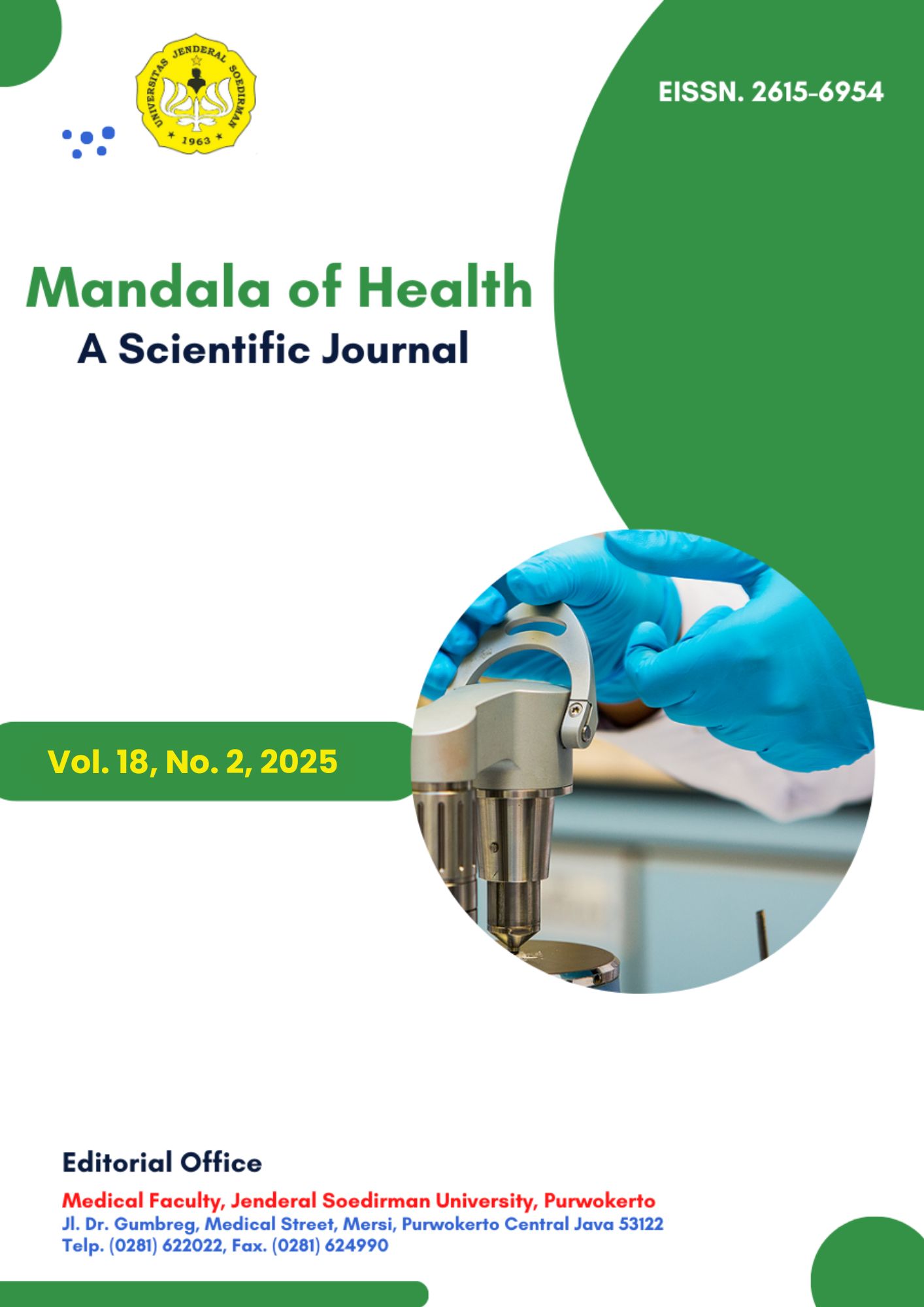THE RELATIONSHIP BETWEEN PREVENTIVE ATTITUDES AND THE INCIDENCE OF EXTENDED SPECTRUM BETA-LACTAMASE (ESBL)-PRODUCING ENTEROBACTERIACEAE CARRIERS AMONG HEALTHCARE WORKERS IN HOSPITALS
Abstract
Infections caused by Extended Spectrum Beta-Lactamase (ESBL)-producing Enterobacteriaceae have become a serious health issue, particularly in hospital environments. Gram-negative bacteria such as Escherichia coli and Klebsiella pneumoniae are able to produce ESBL, making them resistant to various beta-lactam antibiotics and complicating infection treatment. The spread of ESBL-producing bacteria is often associated with suboptimal infection prevention practices in healthcare facilities, particularly among healthcare workers who may act as vectors in transmittinghese pathogens. This study aimed to determine the relationship between attitudes and the incidence of ESBL-producing Enterobacteriaceae carriers among healthcare workers in hospitals. This research was conducted using secondary data. Data were analyzed using Fisher Exact test. The result showed no significant relationship between attitudes and the incidence of ESBL carriage, as indicated a p-value of 1.000. The conclusion there was no relationship between attitude and the incidence of ESBL-producing Enterobacteriaceae carriage among healthcare workers at RSI Banjarnegara.
References
Bezabih, Y. M., Bezabih, A., Dion, M., Batard, E., Teka, S., Obole, A., Dessalegn, N., Enyew, A., et al. 2022. Comparasion of The Global Prevalence and Trend of Human Intestinal Carriage of ESBL-Producing Escherichia coli Between Healthcare and Community Settings: a Systematic Review and Meta-Analysis. JAC Antimicrobial Resistant. 4(3): 1-12.
Biutifasari, V. 2018. Extended Spectrum Beta-Lactamase (ESBL). Oceana Biomedicina Journal. 1(1): 1–11.
David, L. H. 2008. Control of Communicable Diseases, 19th Edition. Washington DC, American Public Health Association.
Departemen Kesehatan RI. 2019. Waspada Infeksi Saluran Kemih. Jakarta, Depkes RI.
Garamina, H., Warganegara, E. & Sumekar, D. 2017. Analisis Perbandingan Uji Sensitivitas Antibiotik dan Keberadaan Extended Spectrum Beta Lactamase (ESBL) pada Escherichia coli dari Feses Tenaga Medis di Ruang Rawat Inap Dewasa dan Ruang Rawat Inap Anak RSUD Dr. H. Abdul Moeloek Provinsi Lampung. Jurnal Agromed Unila. 4(2): 275–282.
Happy, T. 2020. Perbandingan Escherichia coli Penghasil ESBL pada Usia Neonatal Dini dan Pasca Neonatal di Wilayah Surabaya Utara. Surabaya, Thesis Universitas Airlangga.
Kamate, S., Gautam, N. & Sharma, S. 2020. Knowledge, Attitude and Practices
Regarding Infection Control Measures Among Health Care Professional
Students In A Teritiary Care Centre In India. International Journal of Infectious
Diseases. 101(1): 280–281.
Kementerian Kesehatan Tepublik Indonesia. 2024. Waspada Bakteri Kebal Antibiotik.
Maharani, Y., Yuniarti, N. & Puspitasari, I. 2021. Prevalensi Bakteri Extended-Spectrum Beta Lactamase dan Evaluasi Kesesuaian Antibiotik Definitif pada Pasien Rawat Inap di RSUP dr Soeradji Tirtonegoro Klaten. Majalah Farmaseutik. 17(2): 157–165.
Manuaba, I., Iswari, I. & Pinatih, K. 2021. Prevalensi Bekteri Escherichia coli dan Klebsiella pneumoniae Penghasil Extended Spectrum Beta Lactamase (ESBL) yang Diisolasi dari Pasien Pneumonia di RSUP Sanglah Periode Tahun 2019-2020. Jurnal Medika Udayana. 10(12): 51–57.
Muhajir, A., Purwono, P. & Handayani, S. 2016. Gambaran Terapi dan Luaran Infeksi Saluran Kemih oleh Bakteri Penghasil Extended Spectrum Beta Lactamase pada Anak di RSUD Dr. Soetomo Surabaya. Sari Pediatri. 18(2): 1-11.
Rastuti, M.R., Budayanti, N.N.S., Dwija, I.B.N.P. 2023. Various Types of Extended Spectrum β-Lactamases: a literature review. Journal of Clinical Microbiology and Infectious Disease. 3(2): 29-34.
Rumah Sakit Islam Banjarnegara. 2023. Data Primer RSI Banjarnegara Tahun 2023: Sepuluh Besar Penyakit Rawat Inap.
Saharman, Y. R., Lestari, D.C. 2013. Phenotype Characterization of Beta-Lactamase Producing Enterobacteriaceae in the Intensive Care Unit (ICU) of Cipto Mangunkusumo Hospital in 2011. Acta Medica Indonesiana. 45(1): 11-16.
Sugiyono.2016. Metode Penelitian. Bandung, Alfabeta.
World Health Organization. 2023. Antimicrobial Resistance: Global Repost on Surveillance.

This work is licensed under a Creative Commons Attribution-NonCommercial-ShareAlike 4.0 International License.







